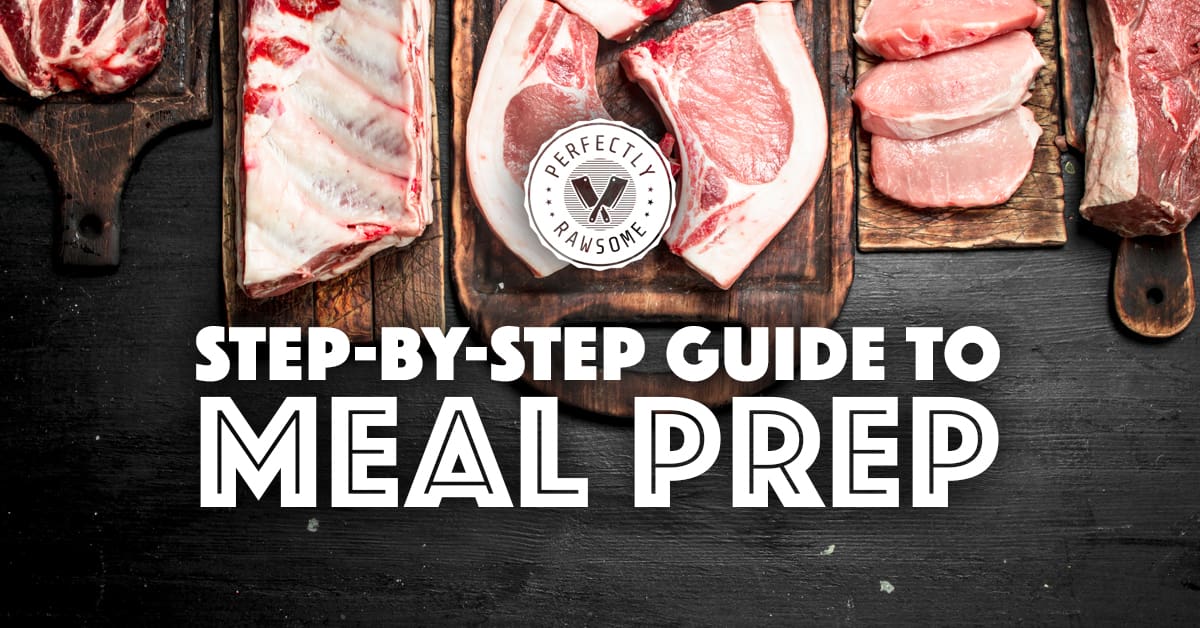Meal prep is an important element to consider when beginning raw feeding. It can be regarded as a time consuming process, but preparing meals ahead of time will save manual labor on a day-to-day basis. However, there is an alternative approach for pet parents who do not want to meal prep.
Whether meal assembly is daily, weekly, or monthly, preparing the diet on paper helps remove the guess work when sourcing, purchasing, and feeding raw. The following steps are useful to become more prepared and learn the skills for an efficient meal prep.

Calculate Feeding Amounts
Calculations propel the meal prep and meal assembly for raw feeding. Daily, weekly, and monthly calculations for ingredients will aid in efficient meal prep. It is recommended to identify how much food is needed and the quantity of each ingredient required to complete meal prep before physically beginning the preparation process.
Step 1: Calculate Daily Feeding Estimates
Raw feeding ratio guidelines are often used to calculate a dog’s feeding requirements. The two common types of guidelines in raw diets are maintenance percentages and ingredient ratios.
These calculations identify the amount of food, ingredients, and calories needed daily.
Maintenance Percentages
Maintenance percentages are used to calculate an estimated quantity (volume) of food to be fed in one day. The maintenance percentage is based on the activity level and life stage of the pet. Remember, these are starting guidelines and should be adjusted to the individual needs. Puppies and kittens have different maintenance percentages in comparison to adult dogs and cats.
Ingredient Ratios
The ingredient ratios are used to calculate an estimated quantity (volume) of each ingredient needed to be fed in one day. PMR (80/10/5/5) and BARF (70/10/5/5/10) model diets have different ingredient ratios. However, the major varying difference is that one diet includes produce and the other does not.
In addition to raw feeding maintenance percentages and ingredient ratios, the amount of calories will determine the amount of energy needed daily.
Calories for Energy
Food provides energy (calories). The diet must provide a sufficient amount of daily calories to maintain ideal body weight. A diet low in calories will result in weight loss and a diet high in calories will result in weight gain. In addition to identifying daily calorie recommendations, calculating energy requirements helps to calculate essential nutrients necessary for a balanced diet as well as determining the dosage for supplements. On average, 1000 calories is roughly 18-20 ounces (510-567 grams) of food. This can be used as an estimated guideline for maintenance percentage calculation and calorie calculation comparison.
Step 2: Calculate Weekly Feeding Estimates
Once daily calculations have been identified, it is time to calculate the amount of food needed for one week (7 days). Multiply the daily feeding calculations by 7 to identify the total amount of food needed for a full week and how much of each ingredient is needed for 7 days.
Meal prep should be smaller when freezer storage space is limited. Using weekly calculations provides an estimate on how much food it needed for 7 days and an estimate on how much is needed of each ingredient.
These calculations identify the amount of food and ingredients needed for seven days which is ideal for weekly meal prep.
Step 3: Calculate Monthly Feeding Estimates
Once weekly calculations have been identified, it is time to calculate the amount for food needed for one month (28-30 days). Multiply weekly feeding amounts by 4 to calculate amounts for 28 days or multiple daily feeding amounts by 30 to calculate amounts for 30 days.
On average US citizens can expect to spend around $2.50/lb to feed a complete raw diet using local resources. Higher budgets allow for more variety but lower costs can often be achieved. This will depend on local resources. Multiply the total amount of food needed for one month by 2.5 to calculate an estimate for a monthly budget.
These calculations identify the amount of food and ingredients for one month which is ideal for monthly meal prep and to calculate monthly budgets.
Plan Recipes & A Meal Rotation
When the hard work is completed in advance on paper, meal prep becomes more efficient. Prepare the raw recipes and meal rotation on paper to help the physical process of prepping go by more smoothly. Following a set of recipes will streamline prep and provide guidance on what items to combine in individual containers.
Example 1
If meal prep is needed to last one week and there are two available recipes, each daily recipe will need to be created 3-4 times to make enough meals to last for a full week.
Example 2
If meal prep is needed to last one month and there are two available recipes, each daily recipe will need to be created 14-15 times to make enough meals to last for 28-30 days.
The amount of labor required for meal prep can be overwhelming for many. It is best to start small and increase the amount and complexity over time. Raw feeding recipes can be purchased from a nutritionist or created using PMR or BARF model guidelines for adult dogs, puppies, or cats. It is best to keep the number of recipes down to a minimum which will make meal prep less overwhelming.
Raw Feeding Meal Prep
At this point all of the homework for meal prep should be completed on paper. Keep the calculations and recipes on hand to provide guidance while preparing individual meals.
Step 1: Prepare All Produce Before Meal Prep
It is recommended to prepare all vegetables, seeds, nuts, and fruit the day before meal prep. This conserves time during meal prep and keeps the assembly line of meal prep moving efficiently. Each produce item has their own recommended preparation method:
Vegetables
Low glycemic vegetables can be pureed raw while starchy vegetables must be cooked.
Seeds and Nuts
Soak most seeds and nuts in a lightly salted water solution for 24 hours before use. Drain them prior to use.
Fruit
Many fruits, like berries, do not need any special preparation for raw feeding.
Produce (veggie) blends are a great way to combine all produce ingredients into one convenient mix to make meal prep easier. Once all seeds, nuts, and vegetables are prepared in their recommended methods, combine and blend together thoroughly to create one large “veggie blend.”
The best way to accomplish a veggie blend is to calculate how much of each ingredient (vegetables, seeds, nuts, and fruit) are needed for the amount of days the meal prep is for. Combine all ingredients into a blender to mix together. Sometimes additional liquid is needed. Coconut water or homemade bone broth are ideal options to use here.
Step 2: Defrost All Raw Ingredients Needed
Start defrosting raw ingredients 12-24 hours before meal prep. This provides sufficient amount of time for the raw meats to defrost. Large quantities can be defrosted in the kitchen sink, bathtub, or large bussing bins to contain any leaks from busted packaging.
Step 3: Prep All Meals
The day is here, it’s time for meal prep! All of the raw ingredients are defrosted, veggie blend is created, calculations and recipes are complete – now all that is left is to assemble individual raw meals. It is recommended to prep one recipe at a time so as not to become overwhelmed.
Gather and divide ingredients for recipe one.
Consolidate the ingredients needed for the recipe one meal prep. Weigh out the amount of muscle meat, RMB, liver, other organs, and veggie blend needed for the entire meal prep. (i.e. 7 days, 30 days, etc.)
Line up individual containers.
Place all meal containers out in a row by the meal prep station. If the pet eats multiple meals a day, one large container can be used for the entire day instead of multiple smaller containers.
Provide supplements daily.
It is best to add any oil supplements (fish, flax, hemp, or vit E) in daily rather than into prepped meal containers. These oils will oxidize when exposed to air in pre-prepped meals.
Add in the RMB to each container.
Once the total amount of RMBs are weighed out for the amount of days for meal prep, evenly divide the total amount of RMBs among the meal containers.
Add in the organs to each container.
Once the amount of secreting organs are weighed out for the amount of days for meal prep, evenly divide the total amount of organs among the meal containers.
Add in the veggie blend to each container.
Once the amount of veggie blend is weighed out for the amount of days for meal prep, evenly divide the total amount of veggie blend among the meal containers.
Complete the meal weight with muscle meat.
Zero out the kitchen scale with an empty meal container. Then place a meal container with the RMB, organs, and veggie blend onto the scale. Finally, complete the total meal weight with boneless muscle meat.
Daily Meal Assembly
Some pet parents do not like the idea of bulk meal prep and that is ok. Daily meal assembly is entirely possible and can be done with some planning. By using Part 1 and Part 2 of this article, the preparation on paper will provide guidance on daily meal assembly.
When storing raw ingredients in the freezer, it is best to store them in increments needed for 5-7 days to avoid spoilage when thawed. Remove the amount of ingredients needed for one week from the freezer to slow thaw in the refrigerator.
Assemble the raw meals each day just before meal time as recommended for meal prep, but the only difference is daily meal assembly is only creating one meal a day for each pet versus multiple meals to individually store in the freezer.
Pros & Cons
Each method has their own pros and cons – it is best for the pet parent to review over the options and decide what works best for their lifestyle.
Pros
Less Overall Time Investment
for Daily Meal Assembly
Easy “Dump and Feed” Convenience
for Meal Prep
Cons
Weigh and Assemble Meals Daily
for Daily Meal Assembly
Time Investment for Meal Prep
for Meal Prep
CLOSING COMMENTS
There are many ways to approach raw feeding, whether through meal prep or daily-meal-assembly. The best way to make DIY efficient for both methods is to prepare the pet’s raw diet on paper. This will serve as a guideline to follow when preparing meals for storage or meal time.
